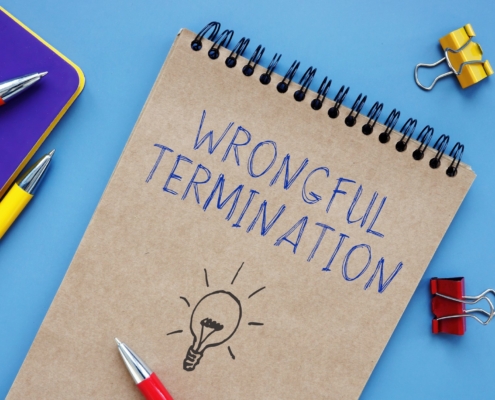Can I be fired for filing an unpaid wages claim?
I got your back if your employer fires you for filing an unpaid wage claim. It is illegal for employers to discriminate or retaliate against an employee who exercises their legal rights. An employer cannot take retaliation including and up to termination. Termination for this reason would be wrongful termination and attract another lawsuit.
When is the deadline for filing an unpaid wage claim?
The statute of limitations for a California wage and hour lawsuit is three years from the date of the most recent violation. California Code of Civil Procedure states:
Within three years:
(a) An action upon a liability created by statute, other than a penalty or forfeiture.
(b) An action for trespass upon or injury to real property.
(c)
(1) An action for taking, detaining, or injuring goods or chattels, including an action for the specific recovery of personal property.
(2) The cause of action in the case of theft, as described in Section 484 of the Penal Code, of an article of historical, interpretive, scientific, or artistic significance is not deemed to have accrued until the discovery of the whereabouts of the article by the aggrieved party, the aggrieved party’s agent, or the law enforcement agency that originally investigated the theft.
(3)
(A) Notwithstanding paragraphs (1) and (2), an action for the specific recovery of a work of fine art brought against a museum, gallery, auctioneer, or dealer, in the case of an unlawful taking or theft, as described in Section 484 of the Penal Code, of a work of fine art, including a taking or theft by means of fraud or duress, shall be commenced within six years of the actual discovery by the claimant or the claimant’s agent, of both of the following:
(i) The identity and the whereabouts of the work of fine art. In the case where there is a possibility of misidentification of the object of fine art in question, the identity can be satisfied by the identification of facts sufficient to determine that the work of fine art is likely to be the work of fine art that was unlawfully taken or stolen.
(ii) Information or facts that are sufficient to indicate that the claimant has a claim for a possessory interest in the work of fine art that was unlawfully taken or stolen.
(B) This paragraph shall apply to all pending and future actions commenced on or before December 31, 2017, including an action dismissed based on the expiration of statutes of limitations in effect prior to the date of enactment of this statute if the judgment in that action is not yet final or if the time for filing an appeal from a decision on that action has not expired, provided that the action concerns a work of fine art that was taken within 100 years prior to the date of enactment of this statute.
(C) For purposes of this paragraph:
(i) “Actual discovery,” notwithstanding Section 19 of the Civil Code, does not include constructive knowledge imputed by law.
(ii) “Auctioneer” means an individual who is engaged in, or who by advertising or otherwise holds the individual out as being available to engage in, the calling for, the recognition of, and the acceptance of, offers for the purchase of goods at an auction as defined in subdivision (b) of Section 1812.601 of the Civil Code.
(iii) “Dealer” means a person who holds a valid seller’s permit and who is actively and principally engaged in, or conducting the business of, selling works of fine art.
(iv) “Duress” means a threat of force, violence, danger, or retribution against an owner of the work of fine art in question, or the owner’s family member, sufficient to coerce a reasonable person of ordinary susceptibilities to perform an act that otherwise would not have been performed or to acquiesce to an act to which the person would otherwise not have acquiesced.
(v) “Fine art” has the same meaning as defined in paragraph (1) of subdivision (d) of Section 982 of the Civil Code.
(vi) “Museum or gallery” shall include any public or private organization or foundation operating as a museum or gallery.
(4) Section 361 shall not apply to an action brought pursuant to paragraph (3).
(5) A party in an action to which paragraph (3) applies may raise all equitable and legal affirmative defenses and doctrines, including, without limitation, laches and unclean hands.
(d) An action for relief on the ground of fraud or mistake. The cause of action in that case is not deemed to have accrued until the discovery, by the aggrieved party, of the facts constituting the fraud or mistake.
(e) An action upon a bond of a public official except any cause of action based on fraud or embezzlement is not deemed to have accrued until the discovery, by the aggrieved party or the aggrieved party’s agent, of the facts constituting the cause of action upon the bond.
(f) (1) An action against a notary public on the notary public’s bond or in the notary public’s official capacity except that a cause of action based on malfeasance or misfeasance is not deemed to have accrued until discovery, by the aggrieved party or the aggrieved party’s agent, of the facts constituting the cause of action.
(2) Notwithstanding paragraph (1), an action based on malfeasance or misfeasance shall be commenced within one year from discovery, by the aggrieved party or the aggrieved party’s agent, of the facts constituting the cause of action or within three years from the performance of the notarial act giving rise to the action, whichever is later.
(3) Notwithstanding paragraph (1), an action against a notary public on the notary public’s bond or in the notary public’s official capacity shall be commenced within six years.
(g) An action for slander of title to real property.
(h) An action commenced under Section 17536 of the Business and Professions Code. The cause of action in that case shall not be deemed to have accrued until the discovery by the aggrieved party, the Attorney General, the district attorney, the county counsel, the city prosecutor, or the city attorney of the facts constituting grounds for commencing the action.
(i) An action commenced under the Porter-Cologne Water Quality Control Act (Division 7 (commencing with Section 13000) of the Water Code). The cause of action in that case shall not be deemed to have accrued until the discovery by the State Water Resources Control Board or a regional water quality control board of the facts constituting grounds for commencing actions under their jurisdiction.
(j) An action to recover for physical damage to private property under Section 19 of Article I of the California Constitution.
(k) An action commenced under Division 26 (commencing with Section 39000) of the Health and Safety Code. These causes of action shall not be deemed to have accrued until the discovery by the State Air Resources Board or by a district, as defined in Section 39025 of the Health and Safety Code, of the facts constituting grounds for commencing the action under its jurisdiction.
(l) An action commenced under Section 1602, 1615, or 5650.1 of the Fish and Game Code. These causes of action shall not be deemed to have accrued until discovery by the agency bringing the action of the facts constituting the grounds for commencing the action.
(m) An action challenging the validity of the levy upon a parcel of a special tax levied by a local agency on a per parcel basis.
(n) An action commencing under Section 51.7 of the Civil Code.
(o) An action commenced under Section 4601.1 of the Public Resources Code, if the underlying violation is of Section 4571, 4581, or 4621 of the Public Resources Code, or of Section 1103.1 of Title 14 of the California Code of Regulations, and the underlying violation is related to the conversion of timberland to nonforestry-related agricultural uses. These causes of action shall not be deemed to have accrued until discovery by the Department of Forestry and Fire Protection.
(p) An action for civil penalties commenced under Section 26038 of the Business and Professions Code.


































